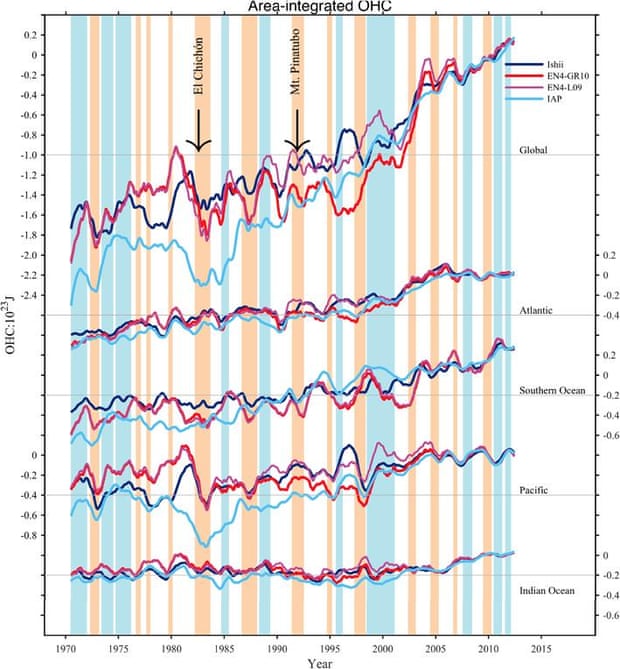New study confirms the oceans are warming rapidly
Posted on 26 June 2017 by John Abraham
As humans put ever more heat-trapping gases into the atmosphere, the Earth heats up. These are the basics of global warming. But where does the heat go? How much extra heat is there? And how accurate are our measurements? These are questions that climate scientists ask. If we can answer these questions, it will better help us prepare for a future with a very different climate. It will also better help us predict what that future climate will be.
The most important measurement of global warming is in the oceans. In fact, “global warming” is really “ocean warming.” If you are going to measure the changing climate of the oceans, you need to have many sensors spread out across the globe that take measurements from the ocean surface to the very depths of the waters. Importantly, you need to have measurements that span decades so a long-term trend can be established.
These difficulties are tackled by oceanographers, and a significant advancement was presented in a paper just published in the journal Climate Dynamics. That paper, which I was fortunate to be involved with, looked at three different ocean temperature measurements made by three different groups. We found that regardless of whose data was used or where the data was gathered, the oceans are warming.

Ocean heat content increase globally (top frame) and in four ocean basins (bottom frames). Illustration: Wang et al. (2017), Climate Dynamics
In the paper, we describe perhaps the three most important factors that affect ocean-temperature accuracy. First, sensors can have biases (they can be “hot” or “cold”), and these biases can change over time. An example of biases was identified in the 1940s. Then, many ocean temperature measurements were made using buckets that gathered water from ships. Sensors put into the buckets would give the water temperature. Then, a new temperature sensing approach started to come online where temperatures were measured using ship hull-based sensors at engine intake ports. It turns out that bucket measurements are slightly cooler than measurements made using hull sensors, which are closer to the engine of the ship.
During World War II, the British Navy cut back on its measurements (using buckets) and the US Navy expanded its measurements (using hull sensors); consequently, a sharp warming in oceans was seen in the data. But this warming was an artifact of the change from buckets to hull sensors. After the war, when the British fleet re-expanded its bucket measurements, the ocean temperatures seemed to fall a bit. Again, this was an artifact from the data collection. Other such biases and artifacts arose throughout the years as oceanographers have updated measurement equipment. If you want the true rate of ocean temperature change, you have to remove these biases.
Another source of uncertainty is related to the fact that we just don’t have sensors at all ocean locations and at all times. Some sensors, which are dropped from cargo ships, are densely located along major shipping routes. Other sensors, dropped from research vessels, are also confined to specific locations across the globe.
Currently, we are heavily using the ARGO fleet, which contains approximately 3800 autonomous devices spread out more or less uniformly across the ocean, but these only entered service in 2005. Prior to that, temperatures measurements were not uniform in the oceans. As a consequence, scientists have to use what is called a “mapping” procedure to interpolate temperatures between temperature measurements. Sort of like filling in the gaps where no data exist. The mapping strategy used by scientists can affect the ocean temperature measurements.
Finally, temperatures are usually referenced to a baseline “climatology.” So, when we say temperatures have increased by 1 degree, it is important to say what the baseline climatology is. Have temperatures increased by 1 degree since the year 1990? Since the year 1970? Since 1900? The choice of baseline climatology really matters.
In the study, we looked at the different ways that three groups make decisions about mapping, bias, and climatology. We not only asked how much the oceans are warming, but how the warming differs for various areas (ocean basins) and various depths. We found that each ocean basin has warmed significantly. Despite this fact, there are some differences amongst the three groups. For instance, in the 300-700 meter oceans depths in the Pacific and Southern oceans, significant differences are exhibited amongst the tree groups. That said, the central fact is that regardless of how you measure, who does the measurements, when or where the measurements are taken, we are warming.
The lead author, Dr. Gonjgie Wang described the importance of the study this way:































 Arguments
Arguments






























So those trying to blame oceans for global warming would appear to be in same boat as those claiming you could reduce deficit and increase government spending while cutting taxes?
Just like money, heat has to come from somewhere.
If we are going to be hotter and more humid then wet bulb temperatures could reach dangerous levels. One cannot cool oneself down below wet bulb temperatures by means of sweating, so one must reduce temperatures or humidity. One can reduce humidity by having a lot of convectional rain and "Understanding the sky" which can be found on the Internet tells us why the clouds are higher in the tropics than at the poles. Most of the tropical rain is conectional and this has "dried out" the atmosphere a bit, making dew points lower. Using Espy's equation tells us that with lower dewpoints (resulting from lower relative humidity) cloud bases are higher. 125 (T-Tdew) is a larger number if Tdew is smaller. Using solar air heaters on every rooftop can dry out air by continuous convection and rain. This will lower wet bulb temperatures.